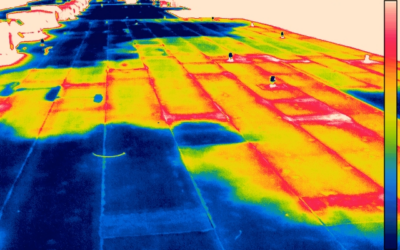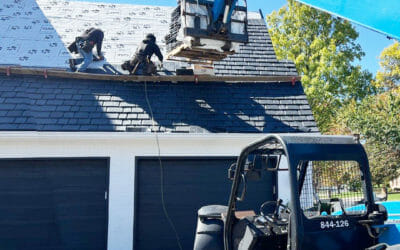Roofing product manufacturer’s often treat 3+ story buildings differently regarding wind rating and warranty than typical single-family homes. For apartment buildings, stacked storage facilities, hotels, and other multifamily properties, this is an important thing to research and know about before planning a roofing construction project.
Property managers are sometimes unaware of ineffective wind damage protection until they realize they don’t have it. Unless you’ve dealt with multi-story roof warranty claims before, you may be unaware that many manufacturers of roofing materials place a warranty limit on structures with three (3) or more stories. For property managers and building owners, this can be a disaster when a storm causes damage to a relatively new roof supposedly under warranty. In these situations, the property manager may have to deal with not just the damage, but also appease the tenants with water in their living room.
Roofing is a critical component of multi-story apartment buildings. Understanding enhanced wind warranties for roofing systems is crucial to ensure the structural integrity and longevity of your property’s roof. This guide is designed to provide property managers with essential information on what to know about enhanced wind warranties, especially for 3+ story buildings.
What to Know: Pre-build Checklist for Review on Wind Warranties
Types of Roofing Materials:
- Be aware that not all roofing manufacturers offer warranties specifically designed for 2+ or 3+ story buildings. Confirm that your chosen manufacturer provides suitable warranties for your building’s height.
- Before delving into warranties, it’s important to know the roofing materials used on your building. Common options include asphalt shingles, metal, clay or concrete tiles, and flat roofing systems like EPDM or TPO.
Enhanced Wind Warranties Defined:
- An enhanced wind warranty is a guarantee from the roofing manufacturer that their product will withstand high winds or wind-driven debris to a certain extent
- Typically expressed in miles per hour (mph) or through uplift resistance values.
Wind Zones and Building Height:
- Understanding your local wind zone is essential as it dictates the minimum wind resistance requirements for roofing materials.
- 3+ story buildings may face greater wind forces, making enhanced wind warranties even more crucial.
Roofing Product Manufacturer’s Warranty:
- Examine the manufacturer’s warranty carefully, paying attention to:
- Wind speed limitations: Ensure that the warranty covers the wind speeds prevalent in your area.
- Duration: Note the warranty period, which can vary from 10 to 50 years or more.
- Transferability: Check if the warranty can be transferred to new property owners.
- Some manufacturers require using multiple components from their product line within a roofing system to qualify for the warranty. Familiarize yourself with these requirements and adhere to them during installation.
Wind Damage vs. Wind-Resistant Products:
- Distinguish between warranties that cover wind damage caused by winds below the rated limit and those that guarantee resistance to higher winds.
- Wind-resistant products are designed to prevent damage, whereas others may only offer compensation for repairs after damage occurs.
Installation Requirements:
- Remember that virtually all product warranties are deemed void if the installation was done incorrectly. Work with a reputable contractor and one who documents the installation process in case any questions arise later related to warranty
- Proper installation is crucial for warranty validity. Ensure that the roofing system is installed following manufacturer guidelines and industry best practices.
- Ensure that your roofing system meets all components needed as per local building codes. Non-compliance could affect warranty eligibility and, more importantly, the safety of your property.
- Hire certified roofing contractors experienced in installing wind-resistant roofing materials.
Maintenance Obligations:
- Many warranties require regular maintenance, which on static materials (most of roofing) is detailed as documented inspections and repairs. Failure to meet these obligations may void the warranty.
- Implement a maintenance schedule and document all inspections and repairs.
- Maintain a proactive approach to identify and address potential issues before they escalate – inspecting just to maintain warranty requirements is fine, but you may find other issues that arise as well.
Wind-Driven Debris:
- Some warranties may cover damage caused by wind-driven debris, as opposed to just the wind itself.
- Confirm if this is included and understand the terms and limitations.
Document Everything (and application process):
- Keep meticulous records of roofing maintenance, inspections, and repairs to provide evidence in case of warranty claims.
- Maintain thorough records of all roofing-related activities, including inspections, maintenance, repairs, and correspondence with the manufacturer. This documentation is crucial for warranty claims and audits.
- It might seem obvious, but it’s crucial to emphasize that you must actively apply for the warranty. This involves submitting necessary documents and information to the manufacturer.
- Make sure copies of the warranty application are distributed to all relevant parties, including the regional manager, local/onsite manager, and the roofing contractor. This ensures everyone is aware of the warranty’s existence and conditions.
Insurance Considerations:
- Understand how your property insurance policy interacts with roofing material warranties and ensure that you have adequate coverage.
Transferability of Warranty:
- Check if the warranty can be transferred to new property owners if you decide to sell the apartment building. This can enhance the property’s value and appeal to potential buyers.
Conclusion:
Enhanced wind warranties for roofing are indispensable for the protection of your apartment building, especially if it’s a 3+ story structure. By familiarizing yourself with these key points and carefully reviewing roofing warranties, you can make informed decisions that contribute to the long-term durability and safety of your property. Remember that proactive maintenance and adherence to best practices are essential to maximize the benefits of enhanced wind warranties.
This article is part of our Multifamily Roofing Comprehensive Planning Guide. Learn more about:
- Ensuring Smooth Projects
- Know Before You Start
- Common Challenge Areas
- Related Education



